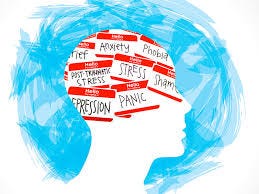Interstellar; Mental Gravity, and the Mumbai Local: A Journey Through ‘Time’ and ‘Mind’
What if black holes weren’t just celestial voids, but reflections of our internal struggles? What if the paradox of time dilation, of gravity bending light, was a metaphor for how suffering distorts?
The rush at Dadar station was the usual chaos — bodies pushing, feet scrambling, voices lost in the cacophony of Mumbai’s lifeline. I had just wrapped up a grueling day of back-to-back MBA lectures, my throat dry from interdisciplinary discussions on street entrepreneurship, financial psychology, and the informal economy.
The local train home was my brief escape, a few square inches of space amidst the sea of people. I plugged in my earphones, seeking solace in Hans Zimmer’s “Interstellar” theme, but with an Indian flute remix — a hauntingly beautiful rendition that blended the cosmic vastness of space with the grounded spirituality of India.
And in that moment, something clicked.
The Mind as a Universe
A sudden realization, a subitism — what Zen monks describe as a flash of enlightenment — hit me. The logical connection between Interstellar, the human mind, and mental health unfolded like an elegant equation.
What if black holes weren’t just celestial voids, but reflections of our internal struggles?
What if the paradox of time dilation, of gravity bending light, was a metaphor for how suffering distorts our perception of life?
I looked around at the sea of exhausted faces in the train — men and women slumped in corners, staring into the void of their screens, lost in thoughts heavier than the steel compartment that carried us. Mumbai’s workforce was a pulsar in itself — dense, relentless, burning bright, yet trapped in the gravity of routine.
The Blackhole of the Mind
In Interstellar, Gargantua, the massive black hole, warps time so dramatically that an hour near its event horizon equals seven years elsewhere.
Isn’t this what depression does? It pulls us into a vortex where time loses meaning, where days stretch into eternities, and hope bends under the weight of despair. The average working Indian spends 52 hours a week on their job, but mental fatigue distorts that experience — what feels like a lifetime is merely another Monday.
India ranks 139th out of 149 countries in the World Happiness Report. 14% of the population suffers from mental disorders, yet discussions around mental health remain trapped in societal stigma. The gravity of expectations, societal norms, and financial pressures warps reality, much like the black hole in Interstellar. The stress of urban life, the endless rat race, and the struggle to stay afloat in one of the world’s most competitive job markets create an event horizon of their own — one where escape seems impossible.
The Multiverse of Possibilities: Quantum Physics and Hope
But then comes the beauty of quantum physics — of probabilities, of possibilities. Cooper, the protagonist, finds himself in a tesseract, a realm beyond time and space, where hope exists in infinite timelines.
What if the mind worked the same way? What if every moment of despair coexisted with a parallel moment of resilience? The Mumbai local is a perfect metaphor — one moment you’re crushed between bodies, unable to breathe, and in the next, you see an open door, the cool night air rushing in, and suddenly, there is space.
Mental health, like quantum mechanics, doesn’t follow a single linear path. We oscillate between struggle and survival, between despair and hope. The Many-Worlds Interpretation of quantum physics suggests that all possibilities exist simultaneously. Perhaps in one reality, we remain trapped in our struggles, but in another, we break free, finding purpose, connection, and meaning.
The data backs this paradox — studies show that India has one of the highest suicide rates in South Asia (16.5 per 100,000 people), yet at the same time, it has one of the most resilient workforces, with 81% of Indian employees willing to upskill and adapt to survive economic changes.
The Interstellar Mindset: Adaptation and Transcendence
Beyond the physics of black holes and quantum entanglement, Interstellar carries a deeper message — the ability to transcend our own limitations. Murphy Cooper, despite her father’s departure, solves the gravity equation. Cooper, lost in space, finds a way home through love and perseverance. It is a metaphor for the grit that psychologists call the key determinant of success. In India, where 63% of the workforce still operates in the informal sector, adaptation is not a choice but a necessity.
The Mumbai local, like life itself, is a test of endurance. It mirrors the philosophy of dharma — the cosmic order, the duty to persist despite suffering. Like a black hole, life will bend, stretch, and distort us. But just as the event horizon isn’t the end — just as Cooper finds his way through the tesseract — our mind, too, can navigate its own darkness and find light.
The Journey Home
The train screeched into my station. I stepped onto the platform, my mind still lost in the vastness of thought, the way astronauts must feel after returning from space — aware of the minuteness of individual existence, yet in awe of its infinite depth.
We are all voyagers, floating through the cosmos of our own minds, searching for habitable planets within our consciousness. Some days we get lost in black holes, some days we bend time in our favor. But if Interstellar taught me anything, it is this:
Love, hope, and resilience are the forces that transcend dimensions. And sometimes, they whisper to us in the form of an Indian flute remix, playing in the backdrop of a Mumbai local, on a journey back home.






really enjoyed this post. Interstellar is my all time favorite movie. I watch it multiple times per year. Great to read your take you added new meaning to the film.